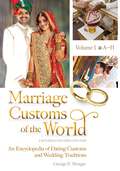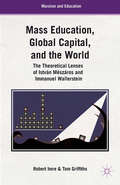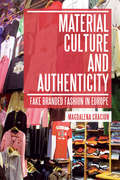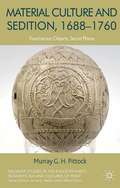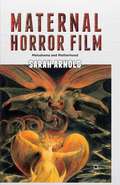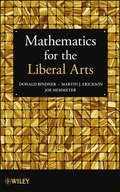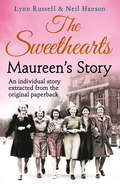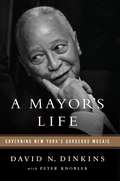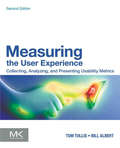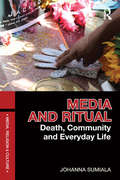- Table View
- List View
Marketing Schools, Marketing Cities: Who Wins and Who Loses When Schools Become Urban Amenities
by Maia Bloomfield CucchiaraDiscuss real estate with any young family and the subject of schools is certain to come up—in fact, it will likely be a crucial factor in determining where that family lives. Not merely institutions of learning, schools have increasingly become a sign of a neighborhood’s vitality, and city planners have ever more explicitly promoted “good schools” as a means of attracting more affluent families to urban areas, a dynamic process that Maia Bloomfield Cucchiara critically examines in Marketing Schools, Marketing Cities. Focusing on Philadelphia’s Center City Schools Initiative, she shows how education policy makes overt attempts to prevent, or at least slow, middle-class flight to the suburbs. Navigating complex ethical terrain, she balances the successes of such policies in strengthening urban schools and communities against the inherent social injustices they propagate—the further marginalization and disempowerment of lowerclass families. By asking what happens when affluent parents become “valued customers,” Marketing Schools, Marketing Cities uncovers a problematic relationship between public institutions and private markets, where the former are used to leverage the latter to effect urban transformations.
Marketing Schools, Marketing Cities: Who Wins and Who Loses When Schools Become Urban Amenities
by Maia Bloomfield CucchiaraDiscuss real estate with any young family and the subject of schools is certain to come up—in fact, it will likely be a crucial factor in determining where that family lives. Not merely institutions of learning, schools have increasingly become a sign of a neighborhood’s vitality, and city planners have ever more explicitly promoted “good schools” as a means of attracting more affluent families to urban areas, a dynamic process that Maia Bloomfield Cucchiara critically examines in Marketing Schools, Marketing Cities. Focusing on Philadelphia’s Center City Schools Initiative, she shows how education policy makes overt attempts to prevent, or at least slow, middle-class flight to the suburbs. Navigating complex ethical terrain, she balances the successes of such policies in strengthening urban schools and communities against the inherent social injustices they propagate—the further marginalization and disempowerment of lowerclass families. By asking what happens when affluent parents become “valued customers,” Marketing Schools, Marketing Cities uncovers a problematic relationship between public institutions and private markets, where the former are used to leverage the latter to effect urban transformations.
Marketing Schools, Marketing Cities: Who Wins and Who Loses When Schools Become Urban Amenities
by Maia Bloomfield CucchiaraDiscuss real estate with any young family and the subject of schools is certain to come up—in fact, it will likely be a crucial factor in determining where that family lives. Not merely institutions of learning, schools have increasingly become a sign of a neighborhood’s vitality, and city planners have ever more explicitly promoted “good schools” as a means of attracting more affluent families to urban areas, a dynamic process that Maia Bloomfield Cucchiara critically examines in Marketing Schools, Marketing Cities. Focusing on Philadelphia’s Center City Schools Initiative, she shows how education policy makes overt attempts to prevent, or at least slow, middle-class flight to the suburbs. Navigating complex ethical terrain, she balances the successes of such policies in strengthening urban schools and communities against the inherent social injustices they propagate—the further marginalization and disempowerment of lowerclass families. By asking what happens when affluent parents become “valued customers,” Marketing Schools, Marketing Cities uncovers a problematic relationship between public institutions and private markets, where the former are used to leverage the latter to effect urban transformations.
Marketing Schools, Marketing Cities: Who Wins and Who Loses When Schools Become Urban Amenities
by Maia Bloomfield CucchiaraDiscuss real estate with any young family and the subject of schools is certain to come up—in fact, it will likely be a crucial factor in determining where that family lives. Not merely institutions of learning, schools have increasingly become a sign of a neighborhood’s vitality, and city planners have ever more explicitly promoted “good schools” as a means of attracting more affluent families to urban areas, a dynamic process that Maia Bloomfield Cucchiara critically examines in Marketing Schools, Marketing Cities. Focusing on Philadelphia’s Center City Schools Initiative, she shows how education policy makes overt attempts to prevent, or at least slow, middle-class flight to the suburbs. Navigating complex ethical terrain, she balances the successes of such policies in strengthening urban schools and communities against the inherent social injustices they propagate—the further marginalization and disempowerment of lowerclass families. By asking what happens when affluent parents become “valued customers,” Marketing Schools, Marketing Cities uncovers a problematic relationship between public institutions and private markets, where the former are used to leverage the latter to effect urban transformations.
Marriage Customs of the World [2 volumes]: An Encyclopedia of Dating Customs and Wedding Traditions [2 volumes]
by George P. MongerThis book presents a comprehensive overview of global courtship and marriage customs, from ancient history to contemporary society, demonstrating the vast differences as well as the similarities across all of human culture.This second edition of Marriage Customs of the World examines historical context, social significance, and current trends and controversies of matrimony in the Western world as well as other cultures. Apart from detailing the ceremonies from specific countries, the book identifies specific elements of the wedding event and discusses them in a comparative manner, showcasing the similarities across cultures. The new content in this work includes additional information on courtship and how future spouses are found in other cultures; marriage in art, cinema, theater, and poetry; wedding bands; forced marriages and shotgun weddings; New Year's weddings; legislation regarding marriage; and engagement practices. Entries carried over from the first edition have been revised and updated as well. With its broad scope and consideration of contemporary issues alongside historical information, this work will be ideal for high school and undergraduate students; scholars of anthropology, social studies, and history; and general readers.
Mass Education, Global Capital, and the World: The Theoretical Lenses of István Mészáros and Immanuel Wallerstein (Marxism and Education)
by T. Griffiths R. ImreBy presenting a series of intricate analyses of educational phenomena through the theoretical lenses offered by Immanuel Wallerstein and István Mészáros, the book engages readers and helps them to critically analyze their own participation in the global economy, as citizens, policy-makers, and academics or teachers.
Master-Servant Childhood: A History of the Idea of Childhood in Medieval English Culture
by P. RyanAn interdisciplinary synthesis that offers a new understanding of childhood in the Middle Ages as a form of master-servant relation embedded in an ancient sense of time as a correspondence between earthly change and eternal order.
Material Culture and Authenticity: Fake Branded Fashion in Europe (Materializing Culture)
by Magdalena CraciunThe study of material culture demonstrates that objects make people just as much as people make, exchange and consume objects. But what if these objects are, in the eyes of others, only fakes? What kind of material mirror are people looking into? Are their real selves really reflected in this mirror? This book provides an original and revealing study into engagements with objects that are not what they are claimed and presumed to be and, subsequently, are believed to betray their makers as well as users. Drawing upon an ethnography of fake branded garments in Turkey and Romania, Material Culture and Authenticity shows how people can make authentic positions for themselves in and through fake objects.The book will be of interest to students and scholars working in the fields of anthropology, material culture and cultural studies as well as to general readers interested in ethnographic alternatives to biographies of famous fakers and fakes.
Material Culture and Authenticity: Fake Branded Fashion in Europe (Materializing Culture)
by Magdalena CraciunThe study of material culture demonstrates that objects make people just as much as people make, exchange and consume objects. But what if these objects are, in the eyes of others, only fakes? What kind of material mirror are people looking into? Are their real selves really reflected in this mirror? This book provides an original and revealing study into engagements with objects that are not what they are claimed and presumed to be and, subsequently, are believed to betray their makers as well as users. Drawing upon an ethnography of fake branded garments in Turkey and Romania, Material Culture and Authenticity shows how people can make authentic positions for themselves in and through fake objects.The book will be of interest to students and scholars working in the fields of anthropology, material culture and cultural studies as well as to general readers interested in ethnographic alternatives to biographies of famous fakers and fakes.
Material Culture and Sedition, 1688-1760: Treacherous Objects, Secret Places (Palgrave Studies in the Enlightenment, Romanticism and Cultures of Print)
by M. PittockMaterial Culture and Sedition, 1688-1760 is a groundbreaking study of the ways in which material culture (and its associated designs, rituals and symbols) was used to avoid prosecution for treason and sedition in the British Isles. The fresh theoretical model it presents challenges existing accounts of the public sphere and consumer culture.
Materiality and Space: Organizations, Artefacts and Practices (Technology, Work and Globalization)
by Francois-Xavier de Vaujany and Nathalie MitevMateriality and Space focuses on how organizations and managing are bound with the material forms and spaces through which humans act and interact at work. It concentrates on organizational practices and pulls together three separate domains that are rarely looked at together: sociomateriality, sociology of space, and social studies of technology. The contributions draw on and combine several of these domains, and propose analyses of spaces and materiality in a range of organizational practices such as collaborative workspaces, media work, urban management, e-learning environments, managerial control, mobile lives, institutional routines and professional identity. Theoretical insights are also developed by Pickering on the material world, Lyytinen on affordance, Lorino on architexture and Introna on sociomaterial assemblages in order to delve further into conceptualizing materiality in organizations.
Maternal Horror Film: Melodrama and Motherhood
by S. ArnoldMaternal Horror Film: Melodrama and Motherhood examines the function of the mother figure in horror film. Using psychoanalytic film theory as well as comparisons with the melodrama film, Arnold investigates the polarized images of monstrous and sacrificing mother.
Mathematical Demography: Selected Papers (Demographic Research Monographs)
by David P. Smith Nathan KeyfitzMathematical demography is the centerpiece of quantitative social science. The founding works of this field from Roman times to the late Twentieth Century are collected here, in a new edition of a classic work by David R. Smith and Nathan Keyfitz. Commentaries by Smith and Keyfitz have been brought up to date and extended by Kenneth Wachter and Hervé Le Bras, giving a synoptic picture of the leading achievements in formal population studies. Like the original collection, this new edition constitutes an indispensable source for students and scientists alike, and illustrates the deep roots and continuing vitality of mathematical demography.
A Mathematics Course for Political and Social Research (PDF)
by Will H. Moore David A. SiegelPolitical science and sociology increasingly rely on mathematical modeling and sophisticated data analysis, and many graduate programs in these fields now require students to take a "math camp" or a semester-long or yearlong course to acquire the necessary skills. Available textbooks are written for mathematics or economics majors, and fail to convey to students of political science and sociology the reasons for learning often-abstract mathematical concepts. A Mathematics Course for Political and Social Research fills this gap, providing both a primer for math novices in the social sciences and a handy reference for seasoned researchers. The book begins with the fundamental building blocks of mathematics and basic algebra, then goes on to cover essential subjects such as calculus in one and more than one variable, including optimization, constrained optimization, and implicit functions; linear algebra, including Markov chains and eigenvectors; and probability. It describes the intermediate steps most other textbooks leave out, features numerous exercises throughout, and grounds all concepts by illustrating their use and importance in political science and sociology. Uniquely designed and ideal for students and researchers in political science and sociology Uses practical examples from political science and sociology Features "Why Do I Care?" sections that explain why concepts are useful Includes numerous exercises Complete online solutions manual (available only to professors, email david.siegel at duke.edu, subject line "Solution Set") Selected solutions available online to students
Mathematics for the Liberal Arts
by Donald Bindner Martin J. Erickson Joe HemmeterPresents a clear bridge between mathematics and the liberal arts Mathematics for the Liberal Arts provides a comprehensible and precise introduction to modern mathematics intertwined with the history of mathematical discoveries. The book discusses mathematical ideas in the context of the unfolding story of human thought and highlights the application of mathematics in everyday life. Divided into two parts, Mathematics for the Liberal Arts first traces the history of mathematics from the ancient world to the Middle Ages, then moves on to the Renaissance and finishes with the development of modern mathematics. In the second part, the book explores major topics of calculus and number theory, including problem-solving techniques and real-world applications. This book emphasizes learning through doing, presents a practical approach, and features: A detailed explanation of why mathematical principles are true and how the mathematical processes work Numerous figures and diagrams as well as hundreds of worked examples and exercises, aiding readers to further visualize the presented concepts Various real-world practical applications of mathematics, including error-correcting codes and the space shuttle program Vignette biographies of renowned mathematicians Appendices with solutions to selected exercises and suggestions for further reading Mathematics for the Liberal Arts is an excellent introduction to the history and concepts of mathematics for undergraduate liberal arts students and readers in non-scientific fields wishing to gain a better understanding of mathematics and mathematical problem-solving skills.
Mathematics for the Liberal Arts
by Donald Bindner Martin J. Erickson Joe HemmeterPresents a clear bridge between mathematics and the liberal arts Mathematics for the Liberal Arts provides a comprehensible and precise introduction to modern mathematics intertwined with the history of mathematical discoveries. The book discusses mathematical ideas in the context of the unfolding story of human thought and highlights the application of mathematics in everyday life. Divided into two parts, Mathematics for the Liberal Arts first traces the history of mathematics from the ancient world to the Middle Ages, then moves on to the Renaissance and finishes with the development of modern mathematics. In the second part, the book explores major topics of calculus and number theory, including problem-solving techniques and real-world applications. This book emphasizes learning through doing, presents a practical approach, and features: A detailed explanation of why mathematical principles are true and how the mathematical processes work Numerous figures and diagrams as well as hundreds of worked examples and exercises, aiding readers to further visualize the presented concepts Various real-world practical applications of mathematics, including error-correcting codes and the space shuttle program Vignette biographies of renowned mathematicians Appendices with solutions to selected exercises and suggestions for further reading Mathematics for the Liberal Arts is an excellent introduction to the history and concepts of mathematics for undergraduate liberal arts students and readers in non-scientific fields wishing to gain a better understanding of mathematics and mathematical problem-solving skills.
Matriarchy and Power in Africa: Aneji Eko
by D. IyamAneji Eko was technically illiterate, but she represents a resource for understanding the complexities of African and Nigerian cultures. This is an account of matriarchy and the complex ties of kinship, their influences in shaping childhood culture, and how they determined cultural expectations across ethnic groups.
Maureen’s story (Individual stories from THE SWEETHEARTS #5)
by Lynn Russell Neil HansonThis is Maureen’s story, one of five stories extracted from THE SWEETHEARTS.Whether in wartime or peace, tales of love, laughter and hardship from the girls in the Rowntrees factory in Yorkshire.
Max Weber (The International Library of Essays in Classical Sociology)
by Alan SicaMax Weber is a magisterial figure in the social sciences. His fundamental contributions to the methodological and conceptual apparatus of sociology remain of continuing relevance to contemporary debates. His astonishing range and quality of work on topics ranging from the comparative sociology of religion to political sociology, and the sociology of law to the sociology of music, have established Weber as a permanent point of reference for modern scholarship. Scholarly debates on the nature, significance and purpose of Weber's work demonstrate a significance for sociology's self-image that extends beyond their immediate interpretive importance. This volume, edited by one of the world's leading Weber scholars, offers an unparalleled selection of key Weber scholarship organized thematically and spanning the range of his sociological influence.
Max Weber (The International Library of Essays in Classical Sociology)
by Alan SicaMax Weber is a magisterial figure in the social sciences. His fundamental contributions to the methodological and conceptual apparatus of sociology remain of continuing relevance to contemporary debates. His astonishing range and quality of work on topics ranging from the comparative sociology of religion to political sociology, and the sociology of law to the sociology of music, have established Weber as a permanent point of reference for modern scholarship. Scholarly debates on the nature, significance and purpose of Weber's work demonstrate a significance for sociology's self-image that extends beyond their immediate interpretive importance. This volume, edited by one of the world's leading Weber scholars, offers an unparalleled selection of key Weber scholarship organized thematically and spanning the range of his sociological influence.
A Mayor's Life: Governing New York's Gorgeous Mosaic
by David N. DinkinsHow did a scrawny black kid-the son of a barber and a domestic who grew up in Harlem and Trenton-become the 106th mayor of New York City? It's a remarkable journey. David Norman Dinkins was born in 1927, joined the Marine Corps in the waning days of World War II, went to Howard University on the G.I. Bill, graduated cum laude with a degree in mathematics in 1950, and married Joyce Burrows, whose father, Daniel Burrows, had been a state assemblyman well-versed in the workings of New York's political machine. It was his father-in-law who suggested the young mathematician might make an even better politician once he also got his law degree.The political career of David Dinkins is set against the backdrop of the rising influence of a broader demographic in New York politics, including far greater segments of the city's "gorgeous mosaic.” After a brief stint as a New York assemblyman, Dinkins was nominated as a deputy mayor by Abe Beame in 1973, but ultimately declined because he had not filed his income tax returns on time. Down but not out, he pursued his dedication to public service, first by serving as city clerk. In 1986, Dinkins was elected Manhattan borough president, and in 1989, he defeated Ed Koch and Rudy Giuliani to become mayor of New York City, the largest American city to elect an African American mayor.As the newly-elected mayor of a city in which crime had risen precipitously in the years prior to his taking office, Dinkins vowed to attack the problems and not the victims. Despite facing a budget deficit, he hired thousands of police officers, more than any other mayoral administration in the twentieth century, and launched the "Safe Streets, Safe City” program, which fundamentally changed how police fought crime. For the first time in decades, crime rates began to fall-a trend that continues to this day. Among his other major successes, Mayor Dinkins brokered a deal that kept the US Open Tennis Championships in New York-bringing hundreds of millions of dollars to the city annually-and launched the revitalization of Times Square after decades of decay, all the while deflecting criticism and some outright racism with a seemingly unflappable demeanor. Criticized by some for his handling of the Crown Heights riots in 1991, Dinkins describes in these pages a very different version of events.A Mayor's Life is a revealing look at a devoted public servant and a New Yorker in love with his city, who led that city during tumultuous times.
A Mayor's Life: Governing New York's Gorgeous Mosaic
by David N DinkinsHow did a scrawny black kid -- the son of a barber and a domestic who grew up in Harlem and Trenton -- become the 106th mayor of New York City? It's a remarkable journey. David Norman Dinkins was born in 1927, joined the Marine Corps in the waning days of World War II, went to Howard University on the G.I. Bill, graduated cum laude with a degree in mathematics in 1950, and married Joyce Burrows, whose father, Daniel Burrows, had been a state assemblyman well-versed in the workings of New York's political machine. It was his father-in-law who suggested the young mathematician might make an even better politician once he also got his law degree. The political career of David Dinkins is set against the backdrop of the rising influence of a broader demographic in New York politics, including far greater segments of the city's "gorgeous mosaic." After a brief stint as a New York assemblyman, Dinkins was nominated as a deputy mayor by Abe Beame in 1973, but ultimately declined because he had not filed his income tax returns on time. Down but not out, he pursued his dedication to public service, first by serving as city clerk. In 1986, Dinkins was elected Manhattan borough president, and in 1989, he defeated Ed Koch and Rudy Giuliani to become mayor of New York City, the largest American city to elect an African American mayor. As the newly-elected mayor of a city in which crime had risen precipitously in the years prior to his taking office, Dinkins vowed to attack the problems and not the victims. Despite facing a budget deficit, he hired thousands of police officers, more than any other mayoral administration in the twentieth century, and launched the "Safe Streets, Safe City" program, which fundamentally changed how police fought crime. For the first time in decades, crime rates began to fall -- a trend that continues to this day. Among his other major successes, Mayor Dinkins brokered a deal that kept the US Open Tennis Championships in New York -- bringing hundreds of millions of dollars to the city annually -- and launched the revitalization of Times Square after decades of decay, all the while deflecting criticism and some outright racism with a seemingly unflappable demeanor. Criticized by some for his handling of the Crown Heights riots in 1991, Dinkins describes in these pages a very different version of events.A Mayor's Life is a revealing look at a devoted public servant and a New Yorker in love with his city, who led that city during tumultuous times.
Measuring the User Experience: Collecting, Analyzing, and Presenting Usability Metrics (Interactive Technologies)
by William Albert Thomas TullisMeasuring the User Experience was the first book that focused on how to quantify the user experience. Now in the second edition, the authors include new material on how recent technologies have made it easier and more effective to collect a broader range of data about the user experience. As more UX and web professionals need to justify their design decisions with solid, reliable data, Measuring the User Experience provides the quantitative analysis training that these professionals need. The second edition presents new metrics such as emotional engagement, personas, keystroke analysis, and net promoter score. It also examines how new technologies coming from neuro-marketing and online market research can refine user experience measurement, helping usability and user experience practitioners make business cases to stakeholders. The book also contains new research and updated examples, including tips on writing online survey questions, six new case studies, and examples using the most recent version of Excel.Learn which metrics to select for every case, including behavioral, physiological, emotional, aesthetic, gestural, verbal, and physical, as well as more specialized metrics such as eye-tracking and clickstream dataFind a vendor-neutral examination of how to measure the user experience with web sites, digital products, and virtually any other type of product or systemDiscover in-depth global case studies showing how organizations have successfully used metrics and the information they revealedCompanion site, www.measuringux.com, includes articles, tools, spreadsheets, presentations, and other resources to help you effectively measure the user experience
Media and Ritual: Death, Community and Everyday Life (Media, Religion and Culture)
by Johanna SumialaThis wide-ranging and accessible book offers a stimulating introduction to the field of media anthropology and the study of religious ritual. Johanna Sumiala explores the interweaving of rituals, communication and community. She uses the tools of anthropological enquiry to examine a variety of media events, including the death of Michael Jackson, a royal wedding and the transgressive actions which took place in Abu Ghraib, and to understand the inner significance of the media coverage of such events. The book deals with theories of ritual, media as ritual including reception, production and representation, and rituals of death in the media. It will be invaluable to students and scholars alike across media, religion and anthropology.
Media and Ritual: Death, Community and Everyday Life (Media, Religion and Culture)
by Johanna SumialaThis wide-ranging and accessible book offers a stimulating introduction to the field of media anthropology and the study of religious ritual. Johanna Sumiala explores the interweaving of rituals, communication and community. She uses the tools of anthropological enquiry to examine a variety of media events, including the death of Michael Jackson, a royal wedding and the transgressive actions which took place in Abu Ghraib, and to understand the inner significance of the media coverage of such events. The book deals with theories of ritual, media as ritual including reception, production and representation, and rituals of death in the media. It will be invaluable to students and scholars alike across media, religion and anthropology.

